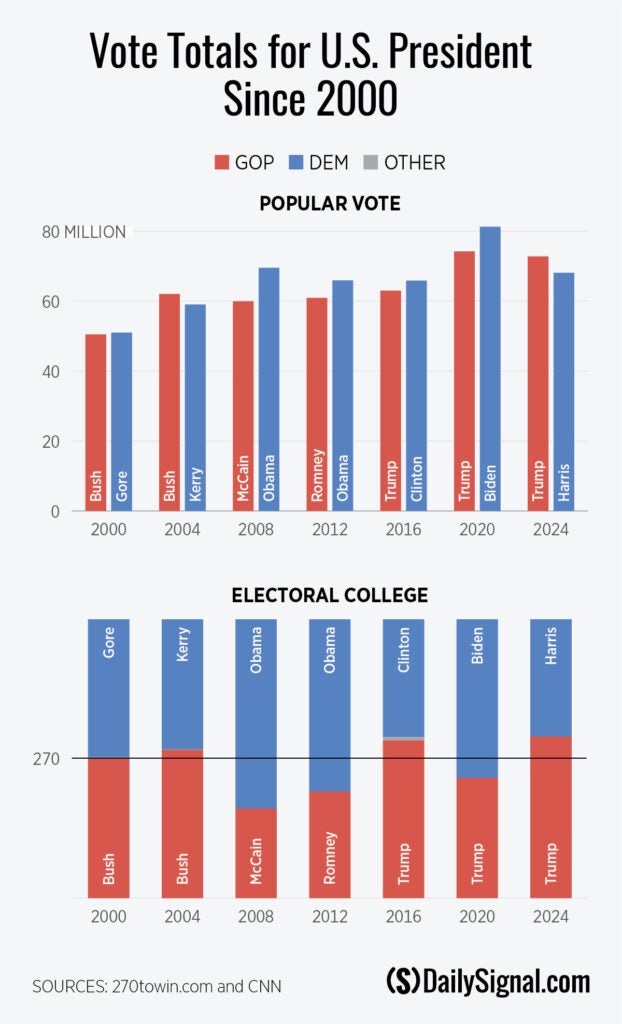ARTICLE AD BOX
Social media posts after the presidential election were abuzz about the disparity in the vote tally from 2020 to 2024.
Preliminary counts show President-elect Donald Trump with almost as many votes as he got in 2020, when he came up short in his reelection effort against Joe Biden. Trump appears to have 73.3 million votes now; in 2020, he won 74.2 million.
But Vice President Kamala Harris appears to have won about 12 million fewer votes than Biden did against Trump in 2020. Biden won 81.2 million votes in 2020; Harris so far has 69 million votes.
This prompted many on the left to claim that “Trump cheated,” while some on the right insisted the results prove that the 2020 election really was rigged. Harris’ vote total this time, they note, was in line with the totals for Democratic presidential nominees Hillary Clinton in 2016 and Barack Obama in 2008 and 2012.
There is no reason to think a decline in Democrats’ voter turnout should raise a red flag, said Hans von Spakovsky, manager of the Election Law Reform Initiative at The Heritage Foundation.
“Turnout of voters can vary greatly from election to election, from race to race, and from state to state,” von Spakovsky told The Daily Signal. “In a typical national election, turnout in different states can also vary greatly. It depends entirely on the candidates, the issues, and the interest voters have in the candidates or the extent of their concern over issues like the economy. When they don’t like their choices, they don’t turn out.”

It’s easier to register today and then vote than at any other time in recent history, he noted.
“There have been absolutely zero reports of anyone being kept from voting and certainly if 20 million people were somehow being kept from voting, that is not something you could keep secret,” von Spakovsky said.
With votes still being counted in several states, turnout for 2024 is on track to be about 62.25% of registered voters, with a total of 152.9 million voters, according to the Election Lab at the University of Florida. That would be down from a 66.38% turnout in 2020, when 159.7 million voters cast ballots.
Arizona, California, Colorado, Oregon, and Washington are among states that tend to be slower at reaching a final count, said Kyle Kondik, managing editor of Sabato’s Crystal Ball at the UVA Center for Politics, a think tank at the University of Virginia.
“There could be 10 million votes that haven’t been counted,” Kondik told The Daily Signal.
However, he stressed this doesn’t “prove” anything.
“The 2020 election was the highest voter turnout in modern times. When you have a record-breaking election, the turnout in following years won’t always follow that record,” Kondik said. “A lot of voters who voted for Biden in 2020 changed their vote to Trump in 2024. Or some didn’t vote. This doesn’t mean there was any voter suppression or voter fraud or anything nefarious. One candidate wins. That’s how it works.”
Once all votes are tallied, Trump could have more votes than he received in 2020, or about the same. This is the first of three presidential elections where Trump won the popular vote as well as the Electoral College.
The 69 million votes tallied for Harris is more than Clinton’s 65.8 million votes in 2016 when she lost to Trump. It’s on par with Obama’s 69.4 million votes in 2008, and higher than Obama’s 65.9 million when he won a second term in 2012.
The COVID-19 pandemic was likely a key factor in driving up voter participation in 2020, since mail-in voting skyrocketed during the lockdowns, said Jacob Neiheisel, a professor of political science at the State University of New York at Buffalo who specializes in voter turnout.
He cautioned that the final vote tally isn’t yet known, and that more information will be clear after the release of the Cooperative Election Study, a Harvard analysis based on pre-election and postelection surveys.
“It seems like COVID may have just been an unusual year. Another likely culprit might include voter ambivalence or alienation,” Neiheisel told The Daily Signal in an email. “It is often the case that voters who don’t find much to like about either candidate will simply stay home on Election Day.”
“Similarly,” he said, “those who feel like their party has ‘left them’ will often do the same, with the hopes of ‘punishing’ their party for not representing their preferred policy positions.”
The post What Explains ‘Missing’ Votes Between 2020 and 2024? appeared first on The Daily Signal.
.png)
 1 week ago
1
1 week ago
1








 English (US)
English (US)